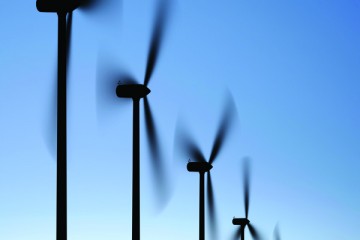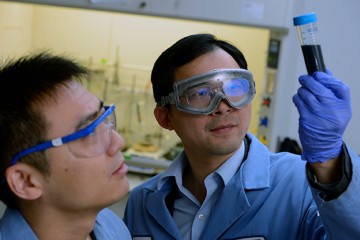Umesh Korde sees the power of our oceans.
For nearly four decades, Korde, a research professor in the Department of Environmental Health and Engineering, has explored how an ocean's force—from violent thrashes to gentle swells—could be harnessed as a source of alternative energy.
"The underlying challenges are as varied and enthralling as the waves themselves," says Korde, when asked why he's drawn to the field.
The idea of wave energy conversion dates back to the oil crisis of the early 1970s, Korde says, but it hasn't gained much mainstream attention or sustained research traction. For one, wave energy converters, which can range from the size of an SUV to that of a small cruise ship, must be engineered to survive large waves. There's also the matter of safeguarding the converters' internal electrical components from the seawater in which they'll be submerged for up to 25 years.

Image credit: Gary Neill
But now may be the time to push for wave energy, says Korde, as policymakers continue to propose ambitious green energy goals in the face of growing energy consumption and a reliance on finite resources such as coal, oil, and gas.
The U.S. Energy Information Administration projects that by 2050, the world will need to produce 900 quadrillion BTU, or 900 quad, of energy annually in order to keep up with projected energy use. In comparison, the world produced approximately 492 quad of energy in 2009, with the number steadily increasing 10 to 15 quad each year since. To put these figures in perspective: One quad is roughly the amount of energy that would keep 26 million U.S. houses powered yearlong.
If about half of our energy supply were to come from renewable sources, Korde says, the space and resource requirements—such as land for more solar panels and windmills—could exceed what many countries have available. But if old ships and submarines could be turned into wave energy converters, global energy demand could be met using a fraction of the land area. Each time a wave would hit one of these devices, the device would move along with it, turning that kinetic energy into electricity.
Wave energy converters could be especially useful during natural disasters, when power supply is disrupted for days, Korde says. When a hurricane damages an area's power grid, nearby grids will typically pitch in to carry the load of the damaged grid. When other grids aren't close enough—as was the case in Puerto Rico, following Hurricane Maria—or there isn't sufficient energy to spare, however, Korde says a daisy chain of mobile, floating generators from the shoreline out to sea could help restore power more quickly. In a recent article in the Journal of Renewable and Sustainable Energy, Korde calculated that it would take a wave energy device about the size of a Honda Pilot, working one to three hours, to provide energy for one home for one day. With roughly 200 of these generators, enough energy could be produced over three days to start powering more than 1,000 homes.
"Being able to bring in power sources by sea to storm-ravaged regions is a distinct advantage," Korde says. "These devices could greatly relieve the burden on damaged roadways, batteries, emergency diesel generators, and limited supplies of generator fuel."
Next, Korde is eager to prove wave converters' capabilities for uses such as self-powering ocean buoys, which currently use batteries, wind turbines, or solar panels. Oceanographers and climate scientists often rely on these small buoys to provide continuous direct measurements of ocean properties such as water temperature, density, salinity, and plankton levels.
The National Science Foundation recently awarded Korde's team a two-year, $300,000 grant to test whether ocean-sensing buoys can successfully rely on wave power. The researchers will test a new technique to control the buoys' rocking back and forth as they're hit by waves, allowing them to convert energy amounts that would otherwise require inconveniently large devices. "It's encouraging to see the Department of Energy and our national labs continue to expand their leadership in this area, as more commercial entities and developers join the quest to bring wave energy into the mainstream," he says.
Posted in Science+Technology
Tagged sustainability, alternative energy









